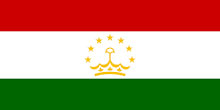
| Home |
|
 |
|
___ Political Map of Tajikistan (Republic of Tajikistan; in Tajik: Ҷумҳурии Тоҷикистон, Jumhurii Tojikiston) | |
About Tajikistan |
|
| Map is showing Tajikistan, a landlocked republic in central Asia, north of Afghanistan, southeast of Uzbekistan and south of Kyrgyzstan, it borders China in east. With an area of 143,100 km², the country is less than half the size of Italy, or slightly smaller than the U.S. state of Wisconsin. Tajikistan has a population of 8.35 million people (in 2015). Capital and largest city is Dushanbe (Душанбе). Spoken languages are Tajik (official) and Russian. Tajikistan's landscape is mountainous, dominated by the Pamir and the Alay Mountains. Peak Ismoili Somoni 7,495 m (24,590 ft) in the Pamir range is the highest peak in the country. Depicted on the map are cities, and towns (see below), main roads, railroad and primary airports. |
 Bookmark/share this page 
|
 One World - Nations Online all countries of the world |
|
|
||
 Political Map of Tajikistan |
|||||||
| Tajikistan Cities and Towns: Depicted on the map are the location of following Tajik cities and towns: Ayni, Buved, Childara, Chkalovsk, Dangara, Dashtishur, Dushanbe, Dzhartyrabot, Garm, Hisor (Gissar), Isfara, Ishkashim, Jirgatal, Kalaikhum, Kalininabad, Kalot, Kanibadam, Kargovad, Kazidi, Khorugh, Khovaling, Khujand, Kofarnikhon, Kolkhozabad, Komsomolabad, Kudara, Kulob (Kulyab), Lairon, Moskovskiy, Murgab, Navabad, Nizhniy Panj, Nurek, Obigarm, Panj, Panjakent, Qurghonteppa (Kurgan-Tyube), Rangkul, Rushan, Sayod, Shaartuz, Shahriostan, Shaymak, Shuroabad, Sicharog, Taboshar, Tavildara, Tursunzade, Uroteppa, Vanj, Vir, Vrang, and Wakhion. | More about Tajikistan: Cities: Country: Tajikistan key statistical data. Continent: Reference Map of Southwestern Asia and the Middle East. |
Current Weather Conditions Dushanbe |
Related Consumer Information:
|
||||
Other Countries in Central Asia: Maps of Countries in Central Asia: Afghanistan Map | Kazakhstan Map | Kyrgyzstan Map | Turkmenistan Map | Uzbekistan Map |
|||||||
One World - Nations Online .:. let's care for this planet Every nation is responsible for the current state of our world. |
| Site Map
| Information Sources | Disclaimer: Privacy Policy, etc. Contact: [email protected] | Copyright © 1998-2021 :: nationsonline.org |